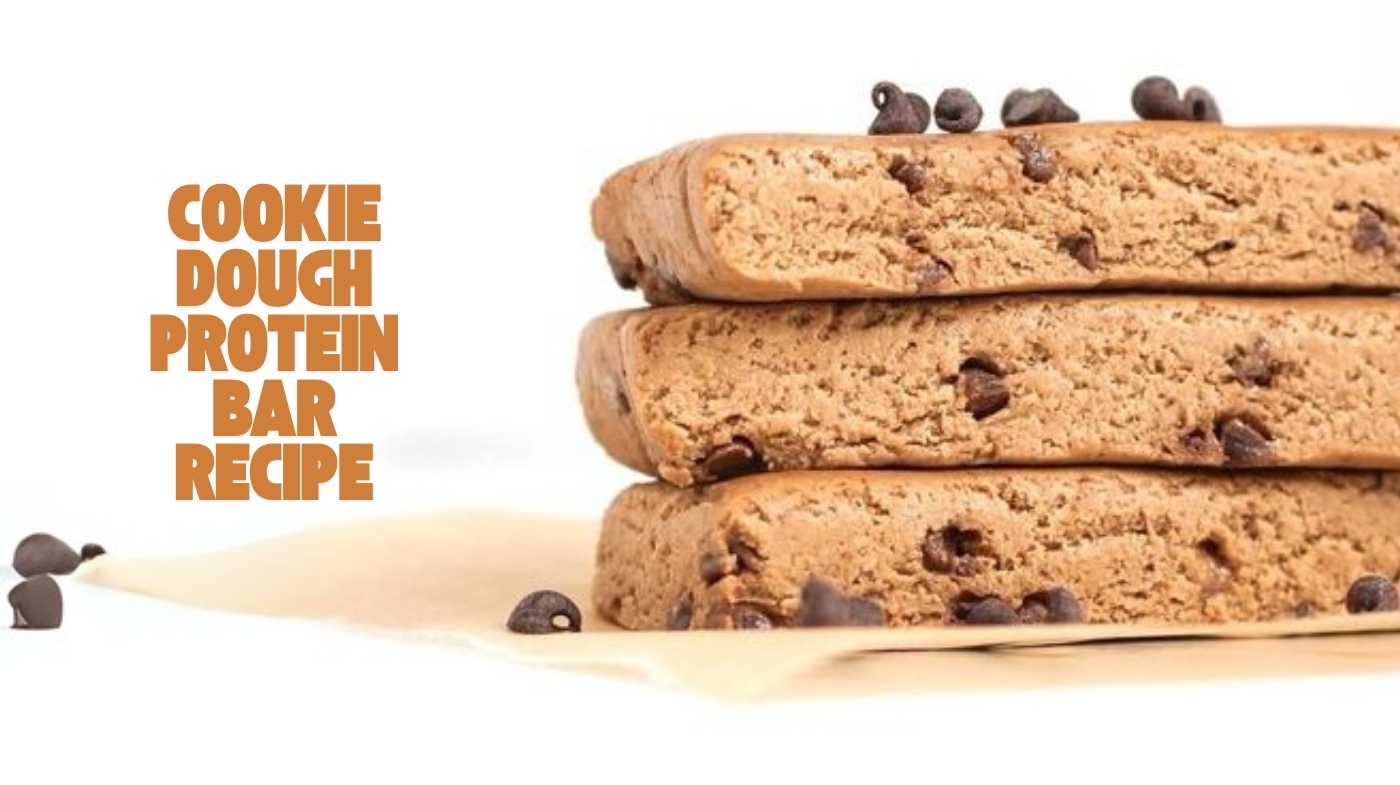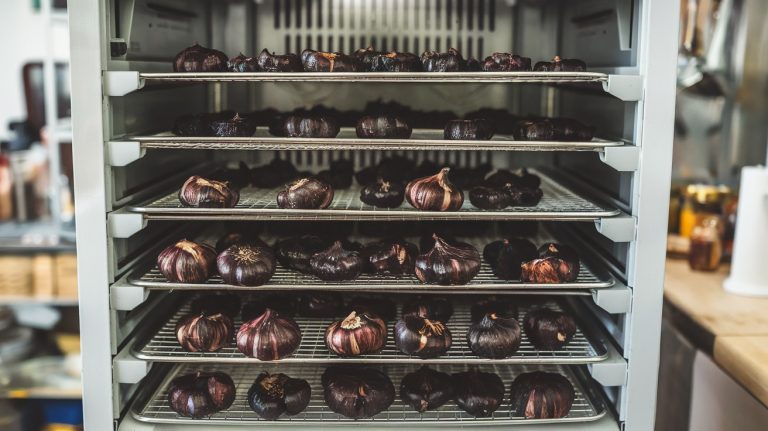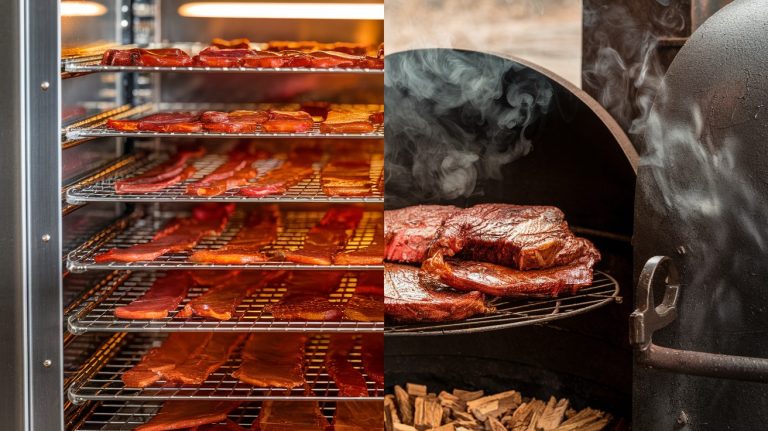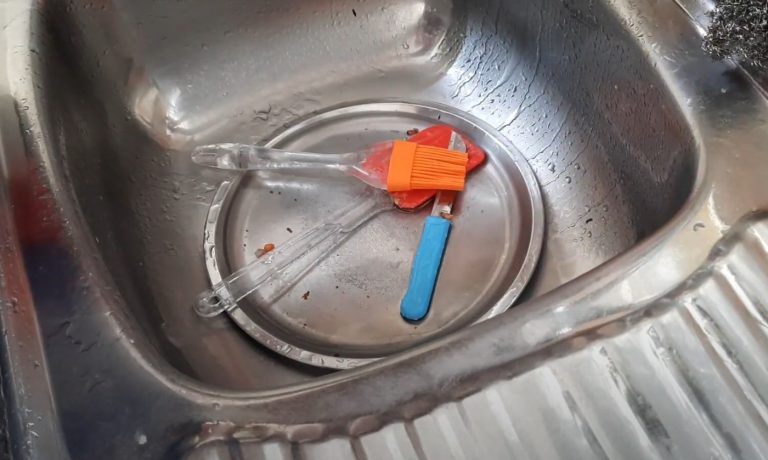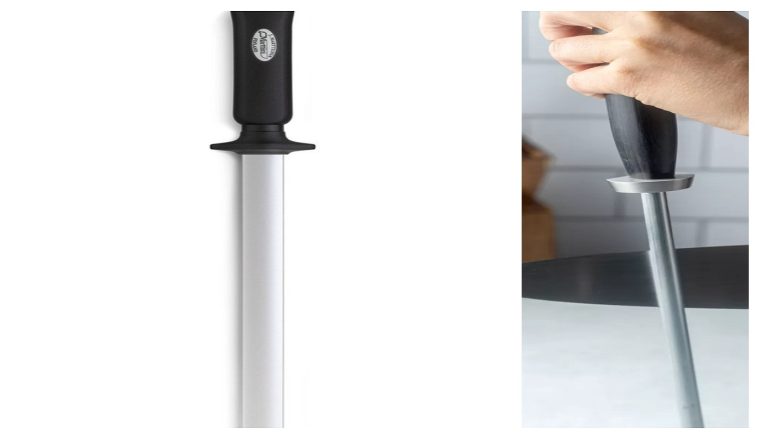Cookie Dough Protein Bar Recipe: Homemade Energy Boost
You can make cookie dough protein bars by mixing natural nut butter with your choice of protein powder, such as whey or plant-based, to reach 11–30g protein per bar. Add oat or almond flour for texture, and bind with honey or maple syrup.
Gradually combine wet and dry ingredients until you get a thick, pliable batter. Press into a lined pan, chill for a few hours, then slice. These bars balance sweet, chewy texture with nutrition. Discover ingredient tips and shaping tricks to perfect your bars.
Key Takeaways
- Use natural nut butters like almond or peanut as a protein-rich, creamy binder for the cookie dough base.
- Incorporate 11–30g of neutral-flavored protein powder and natural sweeteners like honey or dates for taste and texture.
- Mix wet and dry ingredients thoroughly until a thick, pliable dough forms, avoiding clumps and overmixing.
- Press dough firmly into a parchment-lined pan, refrigerate for 2+ hours, then slice into bars for clean edges.
- Store bars refrigerated up to two weeks or freeze for longer freshness; customize with add-ins like chocolate chips or sea salt.
Quick Guide to Cookie Dough Protein Bars
| Ingredients / Tools | Steps / Actions |
|---|---|
| Nut Butter (almond, peanut, or cashew) – 1 cup | Warm gently in a microwave or on low heat to improve mixing and binding. |
| Protein Powder (whey, plant-based, or egg white) – 1 cup | Mix gradually into the nut butter base until smooth. Aim for 11–30g protein per bar. |
| Oat or Almond Flour – 1/2 cup | Combine with protein powder for texture and structure. Adjust amount for desired consistency. |
| Sweetener (honey, maple syrup, or date paste) – 1/3 cup | Add to nut butter while warming; ensures even sweetness and helps bind ingredients. |
| Coconut Oil – 2 tbsp | Incorporate if needed for smooth dough and moisture. |
| Optional Mix-Ins (chocolate chips, cacao nibs, nuts, dried fruit) | Fold in gently after base is mixed to maintain texture. |
| Parchment-Lined Pan (8×8 or 9×5 inches) | Press dough firmly into pan, spreading evenly for compact, uniform bars. |
| Refrigerator | Chill for 2+ hours (or overnight) to firm bars before slicing. |
| Knife | Slice bars carefully, wiping the blade between cuts for clean edges. |
| Airtight Container | Store bars refrigerated up to 2 weeks or freeze for longer freshness. |
Essential Ingredients for Cookie Dough Protein Bars
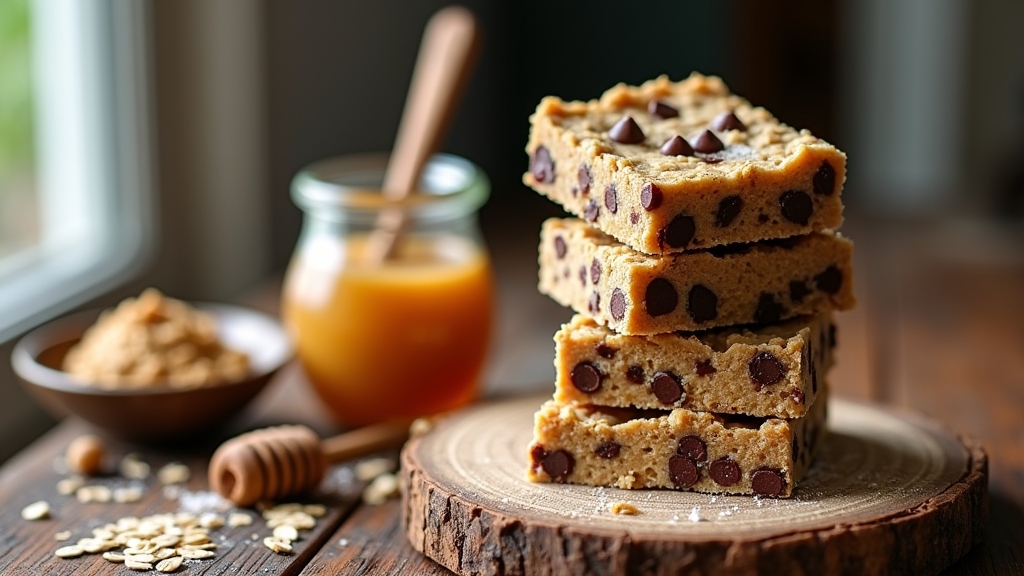
When crafting cookie dough protein bars, choosing the right ingredients is essential to achieve the ideal balance of flavor, texture, and nutrition. Nut butters like almond, peanut, or cashew butter add approximately 7 grams of protein per bar, healthy monounsaturated fats, and help bind ingredients for a no-bake texture. These bars typically contain over 20 grams of protein per serving, making them highly satisfying and filling.
For nut allergies, sunflower or granola butter serve as effective alternatives. Flours such as oat or almond flour provide a gluten-free base, with options like tiger nut or coconut flour catering to dietary needs while enhancing fiber and texture.
Natural sweeteners like maple syrup or honey add sweetness and act as binders, while coconut oil contributes moisture and smoothness. Selecting these components carefully guarantees your bars deliver both taste and health benefits.
Selecting the Right Protein Powder
Choosing the right protein powder plays a significant role in shaping the flavor, texture, and nutritional profile of your cookie dough protein bars. Whey and milk proteins offer creamy textures and efficient muscle repair benefits.
For those seeking multipurpose options, it’s worth noting that some protein powders can complement versatile cooking techniques similar to how a salamander broiler enhances kitchen efficiency with adjustable heat settings.
Selecting the right protein powder is key to flavor, texture, and nutrition in cookie dough protein bars.
While plant-based powders like pea or hemp provide vegan-friendly, allergen-conscious alternatives, they may need flavor masking due to grittiness. Egg white protein presents a lean, dairy-free option ideal for clean-label bars.
Aim for 11–30 grams of protein per serving, balancing fiber (3–6 grams) to enhance digestion and texture. Watch added sugars carefully; natural sweeteners like dates add sugars without refined carbs.
Select powders with neutral flavors and good solubility for smooth mixing. Prioritize third-party tested, non-GMO powders to ensure purity, quality, and transparent labeling, aligning with your dietary and allergen needs. Additionally, it is important to avoid protein powders with soy protein isolate due to processing and digestive issues, which can impact the overall healthfulness of your bars.
Preparing the Nut Butter Base
You’ll want to start by selecting a creamy, natural nut butter without added sugars or oils to guarantee smooth blending and ideal nutrition. Choosing ingredients with non-porous materials helps in achieving easy cleaning later in your kitchen.
Gently warming the nut butter with your chosen sweetener improves its binding properties, helping create a uniform dough when mixed with dry ingredients.
Use thorough mixing techniques to avoid clumps and achieve a consistent texture that presses firmly into your pan.
In this recipe, combining almond butter, raw honey, oats, and protein powder forms the foundational mixture that is naturally firm enough to hold shape without refrigeration due to protein powder’s binding.
Choosing Nut Butter
Since nut butter serves as both the binder and flavor foundation in cookie dough protein bars, selecting the right type considerably impacts texture, taste, and nutrition. You want a nut butter that balances binding ability with complementary flavor and nutritional benefits. Consider these options:
- Peanut butter: Rich in protein and healthy fats, it gives a bold, nutty flavor and firm texture. Its consistency and fat content make it ideal for achieving a stable binding surface.
- Almond butter: Milder taste with more vitamin E and calcium, ideal for a subtler flavor and antioxidant boost.
- Cashew butter: Creamy texture and slightly sweet, it pairs well with tropical or chocolate flavors but has less protein.
Choose natural, smooth nut butters for even mixing and healthier fat profiles. Avoid those with added sugars or excess salt to maintain control over your bar’s flavor and nutrition. Many people prefer nut butters because they contribute to a soft, doughy texture that enhances the overall chewiness of the bars.
Mixing Techniques
After selecting the ideal nut butter for your protein bars, the next step involves preparing a smooth, cohesive base by blending it with liquid sweeteners. Gently warm the nut butter using low heat or brief microwave bursts to reduce viscosity, allowing it to mix evenly with honey, maple syrup, or agave.
This step is crucial because using all-natural peanut butter made with just peanuts and salt ensures the best texture and flavor in the final bars. Using a pan with effective heat distribution can help maintain consistent warming and prevent scorching during this process.
Stir thoroughly until smooth to create a uniform binder essential for structural integrity. Incorporate small amounts of coconut oil if needed to improve spreadability and moisture.
Once the nut butter and sweeteners are fully integrated, gradually add dry ingredients like protein powder and oats, mixing consistently with a sturdy spatula to avoid clumps and ensure even distribution.
Maintain moderate temperatures throughout to preserve ingredient quality and achieve a pliable, firm dough ready for shaping.
Incorporating Sweeteners and Flavors
When crafting cookie dough protein bars, selecting the right sweeteners and flavor enhancers plays a crucial role in balancing taste, texture, and nutritional goals. You’ll want to contemplate how different sweeteners affect not just sweetness but also texture and aftertaste. It is important to rinse baking tools thoroughly to avoid any residue buildup that might alter flavor.
Here’s what to keep in mind: Natural sweeteners like stevia and monk fruit offer calorie-free sweetness but may introduce bitter or metallic notes, which can impact flavor acceptance. Sugar alcohols such as erythritol provide lower calories but might cause digestive discomfort in some people. It is important to be aware that sugar alcohols can cause digestive issues like gas, bloating, and diarrhea despite their low net carb count.
Sugars like fructose enhance flavor complexity and soften bar texture over time but increase calories and hardness initially.
Mixing and Combining Ingredients
Balancing sweeteners and flavors sets the stage for how your cookie dough protein bars will taste, but blending those ingredients properly determines their texture and structural integrity. Start by thoroughly mixing wet ingredients—nut butters, sweeteners, and extracts—to guarantee even distribution.
It is important to adjust liquid based on the protein powder type, starting with a small amount of water and adding gradually to achieve the right consistency. Using tools like a spiral dough hook can enhance mixing efficiency and help achieve a uniform blend.
Separately, sift or stir dry ingredients, including protein powder and flours, to prevent clumps. Combine wet and dry mixtures using a food processor or by hand, scraping sides frequently for uniformity. Aim for a thick, pliable batter; too liquid signals excess moisture, while a crumbly mix needs more binding agents.
Fold in delicate mix-ins like chocolate chips last to maintain texture. Monitor consistency by pressing a sample and adjust flour or liquid accordingly. Avoid overmixing to prevent dense bars. Proper technique ensures ideal chewiness and structure.
Shaping and Setting the Bars
You’ll want to press the cookie dough mixture firmly and evenly into your lined pan to guarantee compact, uniform bars. Applying consistent pressure helps maintain the bars’ shape and prevents crumbling.
After molding, refrigerate the mixture for at least two hours to allow the bars to firm properly before slicing. Using the right knife weight when slicing can enhance control and produce cleaner cuts.
Pressing and Molding
Although pressing and molding your cookie dough protein bars requires some care, preparing your pan properly sets the foundation for well-shaped, cohesive bars. Start by lining a standard-sized pan (9×5 or 8×8 inches) with parchment or silicone liners, extending edges to create lifting handles. Using a waterproof adhesive to secure liners can prevent shifting during pressing.
Then, press the dough firmly using a spatula or your hands to compact the mixture evenly, filling about three-quarters of the pan height to achieve the ideal density. Avoid air pockets by applying consistent pressure and gently press in any mix-ins for texture. This careful preparation helps ensure a homemade alternative to processed commercial options with better texture and flavor.
- Line the pan with parchment paper extending beyond edges for easy removal.
- Press dough evenly to about 1-inch thickness, ensuring no air gaps.
- Use straight-sided pans to maintain clean edges and bar integrity.
Refrigeration and Firming
Once you’ve pressed and molded your cookie dough protein bars, refrigerate them for 30 minutes to an hour to allow the bars to firm and the mix-ins to set properly.
Refrigeration maintains freshness by keeping nut butters and chocolate chips firm, preventing oil separation and ensuring a consistent texture. These bars are designed for busy individuals who need convenient, nutritious snacks on the go. Using the right storage containers helps maintain the bars’ quality during refrigeration.
Chilling overnight yields firmer bars that are easier to slice and handle. Store bars in airtight containers on parchment paper to avoid moisture absorption and sticking. Keep your fridge at about 4°C (39°F) for ideal preservation.
When ready to eat, let bars sit 15–30 minutes at room temperature to slightly soften without losing firmness, enhancing the “cookie-dough crumble” mouthfeel. Proper refrigeration preserves the natural ingredients, supports safety, and delivers the best flavor and texture experience.
Storage Tips for Freshness and Longevity
When aiming to maintain the freshness and longevity of your cookie dough protein bars, storing them in ideal conditions is essential. Proper storage slows spoilage and preserves texture and nutritional quality.
Follow these tips:
- Store bars in a cool, dry place away from direct sunlight to prevent heat and moisture damage. Most commercially available protein bars are suitable for storage at room temperature. This environment also helps maintain the moisture balance critical for texture retention.
- Refrigerate homemade bars to keep them firm and fresh up to two weeks. Freeze for longer storage, using double wrapping to avoid freezer burn.
- Use airtight containers or resealable bags to minimize oxygen exposure and moisture, labeling with dates to manage freshness.
Avoid temperature fluctuations and repeated thaw-freeze cycles, which promote spoilage. Regularly check for off smells, texture changes, or discoloration to make sure your bars stay safe and tasty.
Customizing Your Cookie Dough Bars
Keeping your cookie dough protein bars fresh is just one part of the process; tailoring them to your taste preferences makes them even better. You can vary nut butters—cashew for authentic cookie dough flavor, almond for subtle sweetness, or peanut for a richer, protein-packed profile. Since these bars are vegan and gluten-free, they fit well into many dietary lifestyles, making customization even more appealing.
Mix-ins like cacao nibs, chopped nuts, or dried fruits boost texture and taste, while spices such as cinnamon add warmth without extra calories. Choose vanilla or neutral-flavored protein powders to maintain flavor balance, adjusting liquids for dough consistency.
For binding and sweetness, opt for organic honey, maple syrup, or date paste, avoiding artificial sweeteners. Finally, customize coatings with white or dark chocolate, caramel layers, or superfood powders, and finish with toppings like sea salt or cacao nibs to enhance flavor complexity and texture.
Nutritional Benefits and Macro Breakdown
Although cookie dough protein bars are often enjoyed as a tasty snack, their nutritional profile offers substantial benefits for muscle repair, energy, and digestive health.
You’ll find they typically contain 20 to 28 grams of high-quality protein from sources like whey and plant blends, supporting muscle growth effectively.
Their balanced macronutrient profile also aids sustained energy release. One popular cookie dough protein bar option contains 190 calories per serving and includes ingredients such as Milk Protein Isolate and Whey Protein Isolate, making it a high-protein option.
Consider these nutritional highlights:
- Protein: Up to 75% of calories from protein with a PDCAAS of 1.0 ensures ideal muscle and tissue repair.
- Carbohydrates and Fiber: 20–22 grams of carbs with up to 12 grams of fiber promote digestive health and stabilize blood sugar.
- Fats and Sodium: 7–9 grams of fat and about 220 mg sodium provide energy and maintain electrolyte balance, especially for active individuals.
Frequently Asked Questions
Can I Freeze These Bars for Longer Storage?
Yes, you can freeze these bars for longer storage, typically up to 3 months without losing quality.
Some users report success freezing them for 6 months if you package them properly in airtight bags or containers.
To maintain texture and flavor, slice the bars before freezing, flash freeze on parchment, and remove excess air from storage bags.
Thaw in the fridge overnight and consume within a few days for best results.
Are These Bars Safe for People With Nut Allergies?
Though knights of old faced dragons, your modern quest is safer: these bars can be nut-allergy friendly if they’re made without nuts or processed in dedicated nut-free facilities. Always check labels for allergen warnings and “may contain” notices, since cross-contamination risks exist.
Look for bars using pea or rice protein instead of nut butters. If certified nut-free, they’re generally safe, but vigilance and label reading remain your best armor.
How Do I Prevent Bars From Crumbling After Cutting?
To prevent bars from crumbling after cutting, press the mixture firmly into the pan to reduce air pockets and guarantee consistent density.
Slice bars while they’re still warm or just cooled, using a sharp knife, and wipe the blade clean between cuts.
Let bars cool completely in the pan, then chill them for at least 30 minutes to improve firmness.
Incorporate glycerin and oils to retain moisture and increase cohesiveness for better structural integrity.
Can I Add Other Mix-Ins Like Dried Fruit or Seeds?
Yes, you can add dried fruit and seeds to your bars. Dried fruit naturally sweetens and acts as a binder, while seeds boost fiber, healthy fats, and protein.
Just chop fruit finely to avoid sogginess and balance moisture since seeds like chia absorb liquid. Mix ingredients thoroughly for uniform texture and consider roasting seeds for flavor.
Adjust sweetness carefully, as dried fruit adds natural sugars, impacting calorie content.
What’s the Best Way to Rehydrate Bars if They Dry Out?
To rehydrate dried bars effectively, gently steam them or microwave wrapped in a damp paper towel for short bursts.
You can also lightly spray bars with water or a flavored liquid for gradual moisture absorption.
Avoid soaking bars too long to prevent sogginess.
Reheat wrapped in foil with a bit of water in the oven to restore moisture while maintaining firmness.
Always add moisture incrementally and allow bars to absorb it fully between applications.
Ready to Create Your Perfect Protein Bar?
Creating cookie dough protein bars combines careful choices and clever crafting to deliver a delicious, nutritious delight. By selecting quality protein powders and perfecting your nut butter base, you guarantee satisfying sustenance.
Sweeteners and flavors seamlessly support your snack’s success, while smart shaping and storage secure freshness. With customization catering to cravings and clear nutritional benefits, you’re equipped to enjoy every bite confidently. Consistent care creates crave-worthy, clean, and convenient cookie dough bars you can trust.

